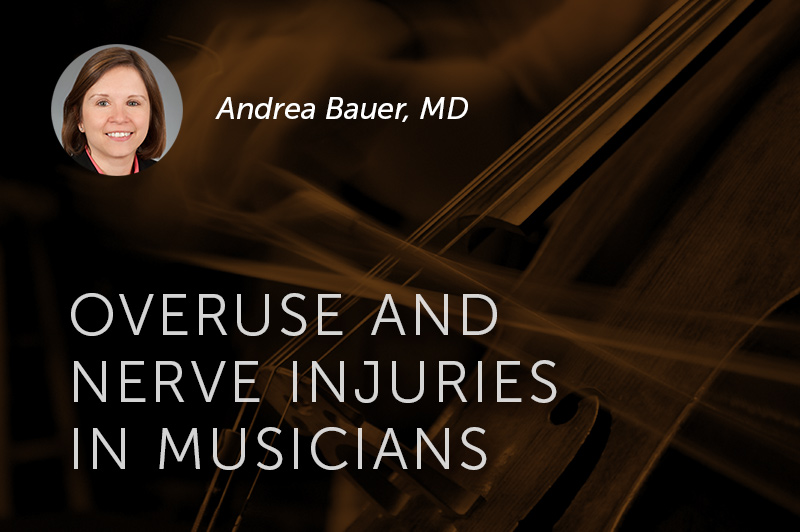What parents of musicians should know about upper extremity injuries

When it comes to orthopedic injuries, sports are usually talked about as high-risk activities, but it’s not often we consider the risk that musicians take when playing an instrument for hours every day.
Musicians can get overuse injuries the same way that athletes do, and are at risk for neck and back injuries, as well as shoulder strain. In particular, nerve injuries in the upper extremities are quite common amongst string instrument musicians, as they tend to hold their instruments in abnormal positions for long periods of time.
While parents may not think that their kid playing an instrument could come with potential injury hazards, these conditions can leave a child or young adult in pain and unable to play. Andrea Bauer, MD, a pediatric orthopedic surgeon in the Hand and Orthopedic Upper Extremity Program at Boston Children’s Hospital details how these injuries occur and what parents should look out for.
Common injuries for musicians
“I see lot of college musicians, and even musicians as young as 14-years-old, who play eight hours a day,” says Dr. Bauer. “And many of my patients are as intense about their art as athletes are about their sport — sometimes even more so, because no baseball player pitches for hours on end, but a musician might practice the violin for eight hours every day.”
Cubital tunnel syndrome is a condition caused by pressure or stretching on the ulnar nerve, which runs along the arm on the inside of the elbow. It can cause numbness or tingling in the fingers, pain in the forearm and weakness in the hand.
Carpal tunnel syndrome is a condition caused by compression on the median nerve as it travels through the wrist. Symptoms include numbness, tingling, burning and pain in the fingers, which can move up the forearm toward the shoulder.
Bauer treats many musicians from the Boston Conservatory at Berklee College of Music for upper extremity conditions and has performed numerous surgeries on bass players in particular. “Depending on their technique, a lot of bass players can get into a position where they are holding their arm and hand in a really awkward position — after a while, it can affect their ability to play and may necessitate treatment.”
Overuse injuries and nerve compression injuries — such as cubital tunnel syndrome and carpal tunnel syndrome – are common amongst high-level musicians, and can often be seen in musicians who may not play as regularly, but have poor technique. Overuse conditions of the upper extremities are also typical of musicians who play string instruments, due to awkward positioning that they may sustain for hours.
If a patient does have a compression neuropathy — caused by direct pressure on a nerve — physical therapists can help get their nerves to move again through nerve glides. They can also assist a musician with posture and core strength, focusing on proper technique and building the necessary muscles to maintain that technique over long periods of time.
Treatment and return to play
Treatment can involve everything from rest and icing to surgery. “I think any person who is a professional-level musician, or is training like a professional-level musician, should be constantly checking in with a physical therapist,” says Bauer. “Physical therapists will then send us patients when they notice that pain or an injury has gotten to a more serious point.”
Bauer treats many musicians for injuries sustained while playing or practicing, but she also helps musicians get back to performing when they have suffered unrelated injuries . “Musicians who are experiencing pain due to playing string instruments are probably who I see the most,” says Bauer. “But I also see a lot of other patients who are trying to work their way back after sustaining other injuries.”
Whether it’s a patient that tore a thumb ligament skiing and now struggles with pain while playing the violin, or a patient who broke her elbow and can no longer extend her arm adequately to play the viola, Bauer works with musicians to get them back to what they love doing most.
Tips for avoiding injury
One of the most important strategies for avoiding injuries — and overuse injuries in particular — is for musicians and their families to recognize when it’s time to take a break from playing. “For any overuse injury, they should be on the lookout for pain that lasts into the next day,” explains Bauer. “Say your child played the trumpet for two hours today and their arm is sore, they shouldn’t be waking up the next day with a sore arm — especially if they’re young.”
Bauer also says that parents should be on the lookout for any change in their child’s form while they are performing or practicing. If they are holding their instrument differently in order to relieve pain that is caused by playing, it can be a clear sign that something is wrong.
If a child or adolescent is experiencing pain from playing, the first step is to stop practicing. Rest is important for recovery, especially if pain persists after playing. If rest doesn’t help relieve the pain — and especially if they are waking up in pain or experiencing pain during other activities — they should see a physician.
“Overtraining is an issue that persists throughout almost any child or adolescent’s activity — whether it’s baseball, dance or playing music,” says Bauer. “Sometimes it’s just about changing what they’re doing, whether that’s changing technique or reducing practice time. But if they end up needing surgery, we do our best to get them back to playing and doing so safely.”
Learn more about the Hand and Upper Extremity Program.
Related Posts :
-

Returning to the stage after cubital tunnel syndrome
Bruno Silva can’t imagine his life without music. He has been playing bass guitar since he was 12 years old ...
-

Questions to ask about your child’s orthopedic care
Maybe your child has an orthopedic injury and needs surgery, or maybe they need to be treated with a different ...
-

Engineered cartilage could turn the tide for patients with osteoarthritis
About one in seven adults live with degenerative joint disease, also known as osteoarthritis (OA). In recent years, as anterior ...
-

My story of bouncing back from osteochondritis dissecans
Injuries suck — no better way of putting it. The physical pain is terrible on its own, but emotionally they can ...





